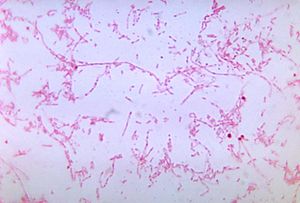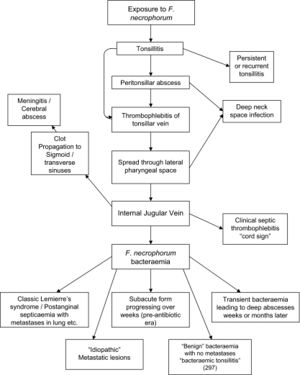Lemierre's Syndrome: Difference between revisions
Griffithjm (talk | contribs) No edit summary |
Griffithjm (talk | contribs) No edit summary |
||
| Line 20: | Line 20: | ||
<br><b>Superscript:</b> Fe<sup>3+</sup> | <br><b>Superscript:</b> Fe<sup>3+</sup> | ||
[[Image:LemierreFlowchart. | [[Image:LemierreFlowchart.jpg|thumb|300px|right|Figure 2. Possible outcomes of infection with <i>Fusobacterium necrophorum</i>. The bacteria can cause a wide range of problems within the host, and this flowchart demonstrates the necessary intermediate steps to pass from one condition to another. Credit to Terry Riordan, 2007. Image obtained from [http://www.ncbi.nlm.nih.gov/pmc/articles/PMC2176048/figure/f7/ Clin Microbiol Rev].]] | ||
<br>Introduce the topic of your paper. What is your research question? What experiments have addressed your question? Applications for medicine and/or environment?<br> | <br>Introduce the topic of your paper. What is your research question? What experiments have addressed your question? Applications for medicine and/or environment?<br> | ||
Revision as of 17:04, 21 April 2016
Section


By Jessie Griffith
At right is a sample image insertion. It works for any image uploaded anywhere to MicrobeWiki.
The insertion code consists of:
Double brackets: [[
Filename: PHIL_1181_lores.jpg
Thumbnail status: |thumb|
Pixel size: |300px|
Placement on page: |right|
Legend/credit: Electron micrograph of the Ebola Zaire virus. This was the first photo ever taken of the virus, on 10/13/1976. By Dr. F.A. Murphy, now at U.C. Davis, then at the CDC.
Closed double brackets: ]]
Other examples:
Bold
Italic
Subscript: H2O
Superscript: Fe3+

Introduce the topic of your paper. What is your research question? What experiments have addressed your question? Applications for medicine and/or environment?
Sample citations: [1]
[2]
Similarly, exposure to the exogenous Fusobacterium necrophorum, which is not a part of normal throat flora does not always result in Lemierre’s syndrome; it can also result in tonsillitis, meningitis, and metastatic lesions, and a whole host of other issues (Fig. 2) [3]
A citation code consists of a hyperlinked reference within "ref" begin and end codes.
Section 1
Include some current research, with at least one figure showing data.
Every point of information REQUIRES CITATION using the citation tool shown above.
Section 2
Include some current research, with at least one figure showing data.
Section 3
Include some current research, with at least one figure showing data.
Section 4
Conclusion
References
- ↑ Hodgkin, J. and Partridge, F.A. "Caenorhabditis elegans meets microsporidia: the nematode killers from Paris." 2008. PLoS Biology 6:2634-2637.
- ↑ Bartlett et al.: Oncolytic viruses as therapeutic cancer vaccines. Molecular Cancer 2013 12:103.
- ↑ Riordan T.. Human infection with Fusobacterium necrophorum (Necrobacillosis), with a focus on Lemierre’s syndrome. Clin Microbiol Rev. 2007;20(4):622-59.
Authored for BIOL 238 Microbiology, taught by Joan Slonczewski, 2016, Kenyon College.
